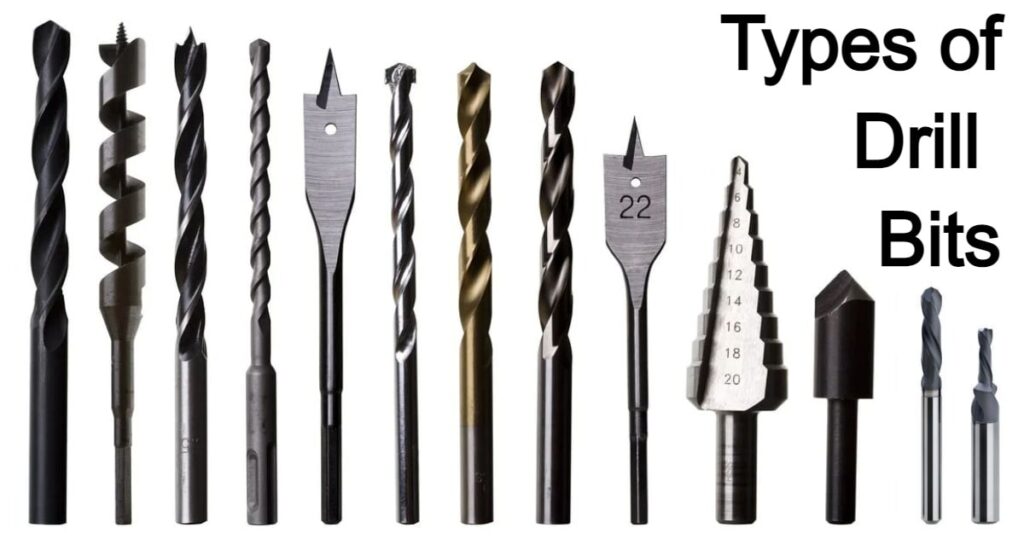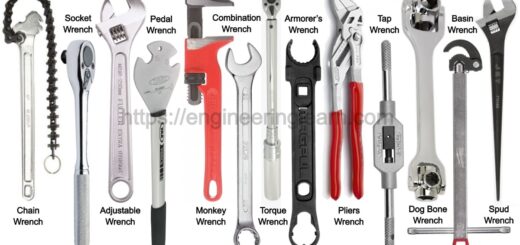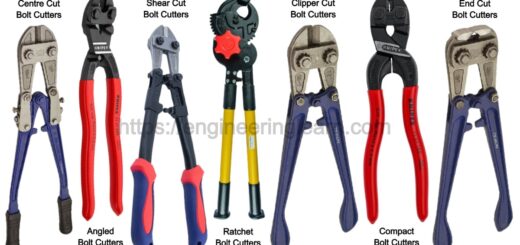Types of Drill Bits

Types of Drill Bits
Introduction:
The cutting tools used in drilling operations, to remove material and create holes, very usually a circular one (circular cross section), are called drill bits. They are used to create a variety of holes in a variety of materials. Thus they come in different shapes and sizes. As already mentioned, they are used in a drill machine. The drill machine transmits the power required to cut the material, to the drill bit. It is done typically by rotation. The upper end of the drill bit is called shank. The drill machine grasps this end in its chuck. The sizes of the drill bits are well standardized and are listed in a comprehensive chart called “Drill bit and tap size chart”. This chart has both types of sizes, metric as well as imperial, along with the required screw tap sizes. While usually the holes drilled have a circular cross section, some specialized drill bits can be used to drill a hole with non circular cross section too.
Properties of drill bits:
Spiral :
This property determines the rate of material removal or say chip removal, during the drilling process. A bit with fast spiral, i.e. the one with higher twist rate is used when large chip removal is required. On the other hand, the drill bit with a low spiral is used when the cutting speed has to be high.
Point angle:
As the name suggests, this is the angle measured at the tip of the drill bit. This angle is determined with respect to the material for which the drill bit is to be used. For soft materials, sharper angle is used. While for hard materials, larger point angle is used. The point angle with respect to a material, plays a role with respect to the rate of wear, chatter, hole shape and wandering.
Lip angle:
Cutting edge of the drill bit needs support and the amount of support it will get is determined by the lip angle. A smaller lip angle will cause the bit to cut less aggressively as compared to a drill bit with a larger lip angle, under same magnitude of point pressure. Both the conditions are not good, as they can cause binding, wear and finally a catastrophic failure of the drill bit.
Functional length:
This property of a drill bit plays a role in determining the depth of the hole which can be drilled using that drill bit. While this can be easily concluded that a longer drill bit, i.e. the one with a larger functional length, will help in drilling deeper holes, such drill bits have a drawback. Due to their length, they become flexible and thus the hole can get drilled in an inaccurate location or it may get misaligned with respect to the intended axis.
Types of drill bits:
There is no single basis to classify the drill bits. They can be classified into various types, on the following basis:
- Size
- Purpose or function : Further divided into:
i) High-Speed Drill Bits
ii) Brad Point Bits
iii) Masonry Bits
iv) Rivet Bits
v) Spade Bits
vi) Installer Bit
vii) Step Bit
viii) Auger Bits
ix) Self-Feed Bit
x) Forstner Bit
xi) Hole Saw
xi) Countersink Bit
xii) Plug Cutter
xiii) Tile Bits
xiv) Adjustable Wood Bit
xv) Annular Cutter
xvi) Bit for Metal
xvii) Chain Saw Blade
xviii) Crown Tooth Fret Saw Blade
xix) Flat Top Grind Saw Blade
xx) Glass and Tile Bit
xxi) Hammer Bit
xxii) High-Speed Cut-Off Wheel
xxiii) Plywood Saw Blade
xxiv) Reverse Skip Tooth Fret Saw Blade
xxv) Rip Saw Blade
xxvi) Segmented Diamond Cutting Wheel
xxvii) Standard Fret Saw Blade
xxviii) Spiral Fret Saw Blade xxix) T-Slot Cutter
Materials used in manufacturing the drill bit:
On this basis, there are six types of drill bits:
i) Soft low-carbon steel bits:
These types of drill bits are very inexpensive. The main drawback with them is that their edges don’t remain sharp consistently. Therefore they need a frequent sharpening. Thus they are only used with wood. Notably, working on hardwood too easily decreases the lifespan of these drill bits.
ii) High-carbon steel bits:
These drill bits can be used for both wood (hardwood and softwood) and metals. The processes of hardening and tempering give these drill bits more durability than the low carbon steel bits. Overheating them must be avoided, because that makes them lose their temper resulting in soft cutting edge.
iii) High-speed steel (HSS) bits:
As the name says, these drill bits ensure a high cutting speed. They are useful for drilling in hardwood, metals, and almost all other materials. They are more durable and heat resistant than their other counterparts.
iv) Cobalt steel alloy bits:
They are a variation of the standard HSS alloy, but they contain higher amount of cobalt. Their higher brittleness is a serious drawback. Their main advantage is their ability to retain their hardness at a very high temperature, thus they can be used with very hard materials where friction causes too much overheating.
v) Tungsten carbide and other carbides:
These materials are very expensive and highly brittle when compared with different kind of steels. Thus they are only used in making the trip of a drill bit. Thanks to their extreme hardness, they can be used to drill almost all materials.
However, nowadays it is becoming common to use solid carbide bits. vi) Polycrystalline diamond (PCD): Among all drill bit materials, these are the hardest ones. Abrasive aluminium alloys, carbon-fibre reinforced plastics, and other abrasive materials need PCD for drilling. These drill bits are not used with ferrous alloys, because this will cause a serious wear in the drill bit due to reaction between the carbon (diamond) and the iron (alloy material).
Coating on the drill bit:
- On the basis of the coating material used, there are following types of drill bits :
i) Black oxide: Along with being inexpensive, they make the drill bit heat and corrosion resistant and also make it lubricated.
ii) Titanium nitride: Being a very hard ceramic material, it is used to coat the HSS steel drill bits.
iii) Titanium Aluminium Nitride: Another coating material, similar to titanium nitride, but better in the qualities like hardness.
iv) Zirconium Nitride
v) Boron-Aluminium-Magnesium BAlMgB14 : It is again a very hard ceramic material and it is used in the applications where composite drilling is involved.
Universal Bits
These are the general purpose drill bits, which can be used for all applications or materials to be drilled, ranging from woods to metals to plastics, etc. They have different examples, like:
Twist drill bits: Today, these drill bits are produced in the largest quantity. These drill bits were invented in 1861 by Steven Morse. Originally these drill bits were manufactured by cutting two grooves on the opposite sides of a round bar and then the bar was twisted, and thus it got the name twist drill bits.
Nowadays it is manufactured by rotating the bar, while it is simultaneously moved past a grinding wheel in order to cut flutes in a similar way as in cutting of helical gears.
- Step drill bits: In these drill bits, the tip of the drill bit is ground to have a different diameter. These type of drill bits are very expensive, because they are usually customised as per different applications.
Uni-bits: These drill bits are roughly conical in shape. Their shape usually has a staircase profile. Their shape helps them in hole enlarging. Main applications include general construction and sheet metal works, and the materials involved are usually soft, like plywood, acrylic polymer etc. It was invented by Harry Oakes.
Uni-bit itself is a trademark of a company named Irwin Industrial Tools, and till 1980, it was manufactured and sold solely by uni-bit corporation as they had the patent.
- Hole saw drill bit: The structure of these drill bits consists of a short hollow cylinder. The other end of this cylinder is open and it has saw teeth like projections. Thus, these drill bits are used to drill relatively larger holes and it must be noted that they do so, without removing a lot of material. Only the material on the edge of the hole is removed, unlike other drill bits which remove all the material from the center of the hole to the edge. These drill bits are used for cutting holes in wood and sheet metals.









